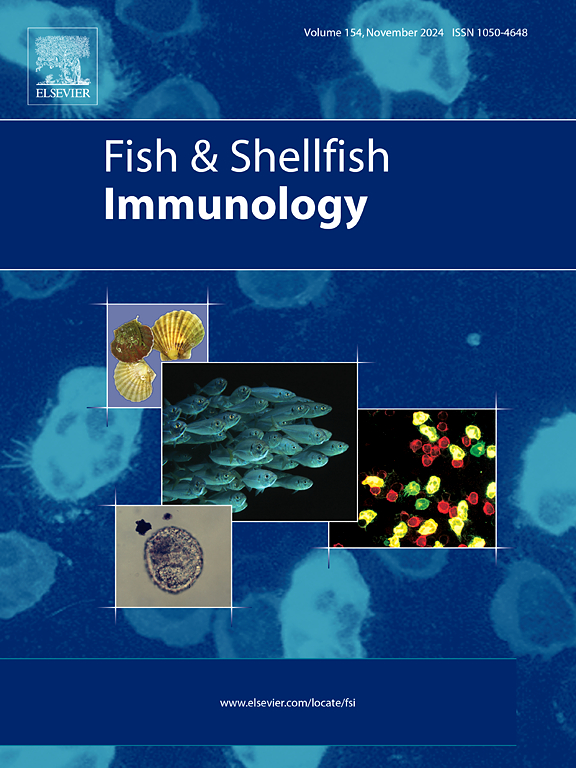神经坏死病毒和哈维弧菌的共同感染增加了橙斑石斑鱼(Epinephelus coioides)的死亡率并加重了疾病的严重程度。
IF 4.1
2区 农林科学
Q1 FISHERIES
引用次数: 0
摘要
不同病原微生物的共感染通常会引起复杂的影响,并受到更多的关注。红石斑鱼神经坏死病毒(RGNNV)和弧菌是鱼类常见的病毒性和细菌性病原体,常在病鱼中同时检出。然而,对RGNNV与弧菌合并感染的认识尚不清楚。本研究建立了石斑鱼(Epinephelus coioides)与哈维弧菌(Vibrio harveyi)共感染RGNNV的模型。与单一病原体感染相比,RGNNV与哈维伊弧菌合并感染引起的病理改变更为严重,死亡率更高(P本文章由计算机程序翻译,如有差异,请以英文原文为准。
Co-infection of nervous necrosis virus and Vibrio harveyi increased mortality and worsened the disease severity in the orange-spotted grouper (Epinephelus coioides)
Co-infections of different pathogenic microorganisms usually cause complex effects, and receive more attention. Red-grouper nervous necrosis virus (RGNNV) and Vibrio are the common viral and bacterial pathogens of fish, and are often detected simultaneously in diseased fish. However, the understanding of co-infection of RGNNV and Vibrio is still unclear. In this study, we have established a grouper (Epinephelus coioides) model of the co-infection of RGNNV and Vibrio harveyi (V. harveyi). Compared with single pathogen infection, co-infection of RGNNV and V. harveyi significantly caused more severe pathologic changes with higher mortality (P < 0.05), and promoted the proliferation of the pathogens by RNA-FISH and qRT-PCR (P < 0.05), demonstrating a synergistic effect of RGNNV and V. harveyi in grouper. Furthermore, we found that V. harveyi inhibited the induction and migration of neutrophils by RGNNV, resulting the obviously reduced neutrophils of co-infection groups (P < 0.05). In addition, transcriptome analysis showed that differentially expressed genes (DEGs) of brain tissues of different experimental groups were enriched in immune signaling pathways, such as JAK-STAT signaling, NF-κB signaling and TNF signaling pathways. For the liver and spleen tissues, the DEGs of different experimental groups were enriched in metabolism-related pathways, such as glycolysis/gluconeogenesis and glycerolipid metabolism. Further analysis of the selected DEGs, co-infection of RGNNV and V. harveyi significantly suppressed the host immune response and up-regulated host glucose and lipid metabolism, compared with single-pathogen infection. Taken together, the RGNNV and V. harveyi make synergic reaction in grouper, possibly due to the down regulation of host immune response and up regulation of metabolism to facilitate the replication of both pathogens. These results provide new insights into the pathogenesis of multiple pathogens, and contribute to develop new therapies.
求助全文
通过发布文献求助,成功后即可免费获取论文全文。
去求助
来源期刊

Fish & shellfish immunology
农林科学-海洋与淡水生物学
CiteScore
7.50
自引率
19.10%
发文量
750
审稿时长
68 days
期刊介绍:
Fish and Shellfish Immunology rapidly publishes high-quality, peer-refereed contributions in the expanding fields of fish and shellfish immunology. It presents studies on the basic mechanisms of both the specific and non-specific defense systems, the cells, tissues, and humoral factors involved, their dependence on environmental and intrinsic factors, response to pathogens, response to vaccination, and applied studies on the development of specific vaccines for use in the aquaculture industry.
 求助内容:
求助内容: 应助结果提醒方式:
应助结果提醒方式:


